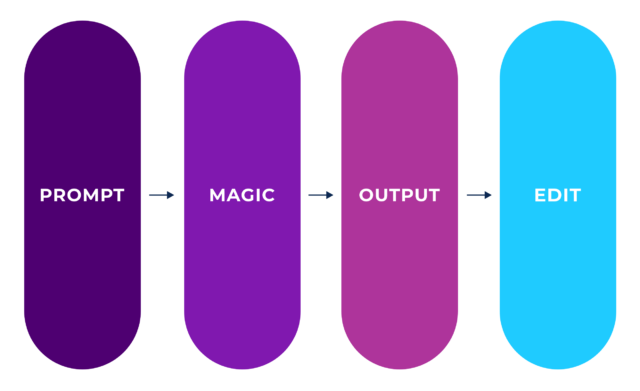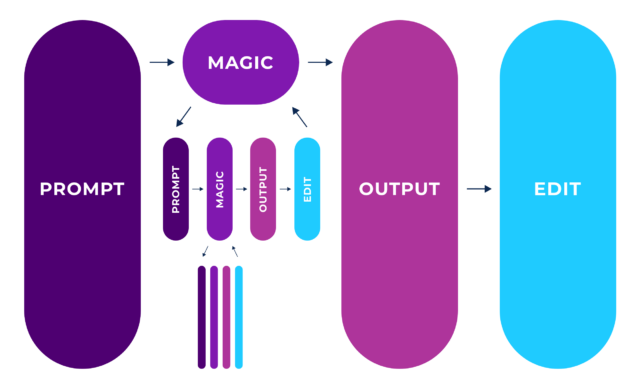I realized things were dire when I was studying several articles on electric vehicles for a project and noticed that all three titles started with “navigating.” Could be a coincidence. But it wasn’t. Because the structure of each title was exactly the same.
You’ve seen it. The AI title. “Short Snazzy Phrase: What the Article is Actually About”
- Navigating the Electric Vehicle Landscape: A Strategic Roadmap for…
- Navigating EV Maintenance: What Dealerships Need to…
- Navigating the Road to Profitability: How Auto Dealers Can…
It’s not a bad title structure.
But it is an overused one. Currently, AI follows a script it’s been taught on what best practices are. It has a preconceived notion of what a good email is, good social media caption, good title, etc. And it uses that, unless prompted otherwise, every. single. time.
When overused, “best practices” become “boring practices.” Predictable. Ignorable.
That being said- This is not an AI-bashing article.
This is an I’m-not-mad-that-we’re-using-AI-I’m-disappointed-with-how-it’s-being-used article.
Like your parents said (unless they didn’t): They’re gonna do it anyway. You might as well help them not mess it up. In fact, I want you to have a good time with AI. I want you to create interesting, effective copy, even if you’re not a copywriter by trade.
And I really really want to stop seeing the same subject lines pop up over and over again in my inbox.
Here’s how to use AI in copywriting in a more original and unique way.
The first tip is so obvious that I’m not even going to give it an H2: Don’t just copy/paste complete AI results without thoroughly editing them. It’s like forgetting to salt your eggs but serving them anyway. Edible, but not great.
Now that we got that one out of the way, here are some real tips for serving perfectly salted scrambled eggs.
1. Understand how AI works.
If you’re in an industry bubble where you write and consume content for and from one single industry, you might not realize just how generic AI results usually are.
Let’s do a thing. It’s going to be fun. Open up your AI writing tool of choice and enter this prompt:
“Write 5 title options for a webinar about digital marketing 101.”
Now copy that prompt, but change the topic. JavaScript 101. Cryptocurrency 101. Woodworking 101. Let’s just say, you’ll see trends. While some words will be industry-specific (i.e. navigating for the auto industry, crafting for woodworking, etc.) the structure behind the words will almost always be the same.
That means your competition for unique, eye-catching copy isn’t just between you and the other companies sending emails to your recipients. It’s between you and everyone else writing anything with AI in the world. You don’t just see this stuff in B2B marketing—it’s on Facebook, in the news, and on the book covers in your favorite bookshop.
Here are a few of the results I got from our previous prompts.
- Unlocking Digital Potential: A Comprehensive Guide to Digital Marketing Basics
- Unlocking the Web: An Introduction to JavaScript
- Unlocking the Crypto Puzzle: An Easy Introduction for Beginners
- Unlock Potential: Essential Benefits for Maximizing Workplace Productivity
- Unlocking the Power of ABM: A Step-by-Step Guide
Or how about:
- From Tree to Treasure: Beginner’s Guide to Woodworking
- From Paris to Provence: An Introduction to French Culinary Arts
- From Landlubber to Sailor: Starting Your Yachting Journey
- JavaScript Foundations: From Zero to Coding Hero
- ABM Fundamentals: From Theory to Practice
So if you really want to stand out, you’ll have to think outside the [unlocked] box. The tips that follow will help you make these more original.
2. Know what words and phrases AI uses and abuses.
You’re going to read this list and nod grimly. You might even sigh.
- Unlock/Unveil
- Elevate
- Explore/Discover
- Embrace
- Potential
- Delve/Dive
- A (vibrant) tapestry of
- In the realm/landscape/world of
- Embark (on a journey/exploration)
- Navigating
- Together, we’ll
What you’re not going to do is just copy/paste this list into ChatGPT and tell it to avoid these words. There’s a time and a place for “elevate” and “landscape.” There might even be a time for “delve.” There might not be one for “embark” though. Don’t use embark.
The tip here is to be aware of what AI is pushing and be purposeful when it really is time to use those words and phrases.
3. Put more time into your prompts.
The principle behind this tip has been covered extensively. If you’re a copywriter, you’ve probably been exposed to a lot of webinar promotions, blogs, LinkedIn posts, YouTube videos, and TikToks about how to craft the perfect prompt.
There’s no single solution for creating a prompt so spectacular that it instantly gets you pastable results. And I hate to break it to you, but there’s no amount of prompt engineering you can do that will get you perfectly pastable results. That kind of magic isn’t yet a reality. The goal is to get closer to final copy—not final copy.
Alex Jonathan Brown, a senior content strategist on the Iron Horse team, recommends a nesting formula for prompts that facilitates the kind of magic AI can’t yet do. Let’s say we need to write an abstract for a webinar.
The process is less:

And more:

Here’s really how to use AI in copywriting:
-
- Prompt: Start by telling your tool what your objective is—to write an abstract for a webinar—and asking if it understands. It will say yes and repeat back to you what it understood.
- Feedback loop 1: Then ask your tool what information it needs in order to write a great abstract. It will output a list of requests, such as topic, objective, target audience, structure, contact information, social proof, and visuals.
- Feedback loop 2: Curate the list and prompt a third time with the information. For example, I don’t want contact information, social proof, or visuals in the abstract, so I cut those out. Submit.
- Output: You’ll get results. You then have three options. Accept it as-is (please don’t choose this one). Figure it’s close enough to iterate on manually. Or take the time to iterate through your tool. (You could also rage quit because it’s still not great, which I have done on…multiple occasions. It’s, admittedly, a quicker option.)
- Feedback loop 3+: If you choose to iterate with AI, you can either prompt it again with a list of overarching requests or highlight different parts of the abstract and work more granularly.
- Edit: Always, no matter what AI gives you after all of your feedback loops, take a minute or two to polish it up before pasting into your copy doc.
The results will probably be okay. But there’s one more step…
4. Ask AI for several options and glean from the best results.
Even after all the previous work, there’s a good chance the results aren’t 100% pastable. Once I have an output that’s close enough, I ask for several variations. Extra credit if you specify nuances to each one, like one that’s longer, shorter, less serious, etc.
From there, I can pick and choose the sentences, phrases, and even words I like best.
It takes a lot of time. You might think to yourself, couldn’t I just write it myself in less time? Yeah, probably! Here are two reasons why you might not do that:
- You’re not a copywriter and feel uncomfortable writing or extensively editing.
- You’re a copywriter and want to break out of your own personal version of “Unlocking…” and “From X to Y”.
AI has tells, but so do you. I use a LOT of short punchy sentences. And I’m obsessed with starting sentences with conjunctions. Italics? Love them. Which brings me to the last tip.
5. Don’t use AI to write copy. Use AI to make yours better.
I recently wrote a longform piece of content. I followed the steps in #3 which included plugging my detailed outline into ChatGPT 4 and asking it to draft the asset.
Long story short, about 20% of what ChatGPT 4 output made it into my final draft.
If I’d added in more feedback loops, I could have probably used more than 20%. Iterating within AI could have made the AI draft less stiff, more closely aligned with what I knew the objectives to be, and overall less predictable. I might have gotten to 30-40%. But at some point it takes more work than it offers improvement.
And I’m not upset about ending up with that fraction. That’s 20% of the draft I might not have thought of on my own. It’s 20% better structure and clearer phrasing than I would have naturally written. It helped me sort through a complex topic and gave me a starting point to iterate from.
The Iron Horse insight.
People and teams across Iron Horse have been experimenting with generative AI since it came out, including building our own ChatGPT-based voice and chat assistants. Beyond using AI to assist in writing copy, it’s been a great tool for brainstorming, outlining, adapting, and personalizing. I know our engineering team uses it to speed up writing code. Our PMs rave about its Excel formula abilities. Check out this webinar on how to leverage AI for content creation without sacrificing quality.
AI is both really cool and really scary. It’s a great tool and also easily a crutch. We don’t have a lot of influence on the former, but hopefully this article helped you out with the latter. At the end of the day, our goal is content that works—whether written the “old-school” way or aided by AI.
P.S. Ironically, I did not use AI to write a single piece of this article, besides the output examples. If I had, it would have held me more strictly to grammar and punctuation rules. It wouldn’t have included the uncomfortably long compound adjective H3. And it would have taken the fledgling analogy of unsalted eggs and woven it more thoroughly (maybe too thoroughly) into the article, instead of the handful of references I ended up with. *Shrug emoji*


